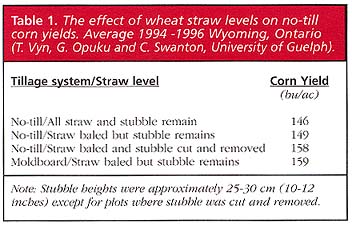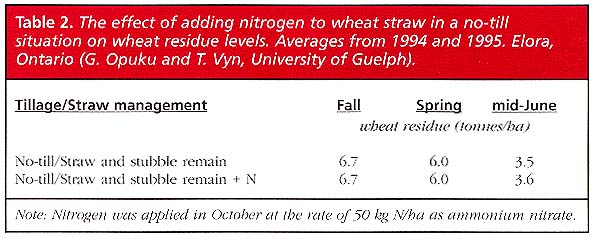
What to do with Wheat Straw
Sell it
Reducing tillage costs for corn, improving net profits, or enhancing the long-term health of your soil requires you to make some decisions about how best to handle wheat straw. Many of these decisions require some action before you head to the wheat field with the combine. In the situation where a producer’s desire is to manage the wheat straw to facilitate no-till or  reduced tillage corn production, the best advice is to remove the wheat straw from the field. Table 1 indicates the corn yields from tillage trials where three different levels of straw were left on the field and no-till corn was planted the following year. Removing straw from fields – especially in high yielding wheat crops and on heavier textured soils – greatly enhances the odds of no-till corn yields being equal to yields obtained with moldboard plowing.
reduced tillage corn production, the best advice is to remove the wheat straw from the field. Table 1 indicates the corn yields from tillage trials where three different levels of straw were left on the field and no-till corn was planted the following year. Removing straw from fields – especially in high yielding wheat crops and on heavier textured soils – greatly enhances the odds of no-till corn yields being equal to yields obtained with moldboard plowing.
Spread it
In situations where removal is not an option, uniform spreading of the straw and chaff is critical for no-till or reduced tillage success in corn. Even in the situation were the straw is to be left in the windrow there is real merit in spreading the chaff as widely and uniformly as possible during the combining operation. In cool, wet springs the lower soil temperatures and poorer growth brought on by spotty mats of decaying wheat residue will make you wish you would have taken a bit more time in July to adjust or modify the combine.
Bury it
Spreading straw uniformly or cutting stubble heights low to remove more straw have considerably less importance if you plan on moldboard plowing the wheat field. University of Guelph studies have shown that corn yields were similar regardless of whether all or part of the straw was plowed down. A frequently asked question is whether returning all the straw to the field and moldboard plowing is better for the soil than cutting the wheat short, baling the straw and planting corn no-till. If you farm where the risks of water and wind erosion are near zero, the benefits of returning all the straw might outweigh the advantages of reducing tillage. But for the majority of farms in Ontario, I believe removing some straw to allow for the erosion protection and soil building benefits of reduced tillage is the better option.
The other point to consider is the potential of using a system where wheat fields are lightly disced in the fall (about three inches deep), left level, and then corn is planted in the spring without any further tillage. Yields under this approach have been consistent year to year and close to those obtained with traditional moldboard tillage. This system can handle considerably higher wheat straw levels than no-till and still represents appreciable cost savings over conventional tillage.
Sprinkle it with nitrogen
 The idea of adding nitrogen to help break down wheat straw has been put forward on several occasions. As recently as 1994 and 1995, this concept was tested by University of Guelph researchers. Table 2 outlines results from a trial where nitrogen was spread on wheat straw in the fall. The additional nitrogen did not cause straw to decay faster, nor were the soil nitrogen levels higher on these plots when tested the following spring.
The idea of adding nitrogen to help break down wheat straw has been put forward on several occasions. As recently as 1994 and 1995, this concept was tested by University of Guelph researchers. Table 2 outlines results from a trial where nitrogen was spread on wheat straw in the fall. The additional nitrogen did not cause straw to decay faster, nor were the soil nitrogen levels higher on these plots when tested the following spring.
Smother it with clover
An interesting observation from work examining corn grown following wheat and wheat underseeded to red clover has been that the presence of the red clover appears to lessen the negative effects of the wheat straw on no-till corn performance. Researchers Tony Vyn and Ken Janovicek from the University of Guelph reported that no-till corn following wheat/red clover (chemically killed in the fall) outyielded no-till corn following wheat alone by 7.5 bu/ac when examined across four sites in the mid-1990s. Dr. Craig Drury from Agriculture and Agri-Food Canada, Harrow, has research results that offer a potential explanation for this superior performance following red clover. He indicates that in his plots, wheat straw decomposes more quickly beneath red clover than in wheat plots that are not underseeded, resulting in less straw in the spring for no-till corn to deal with.
All in all, wheat straw management decisions need to be considered early...and with an eye towards how they will impact future cropping system options.